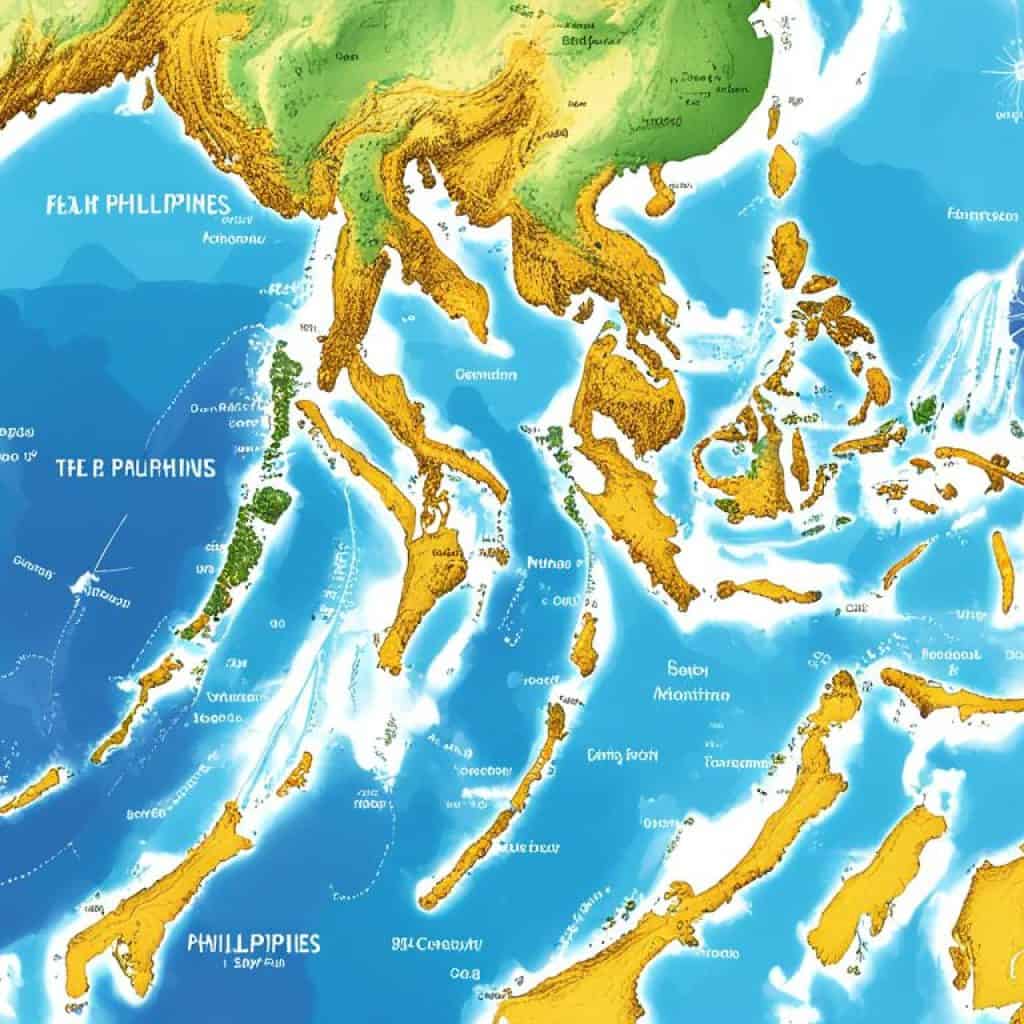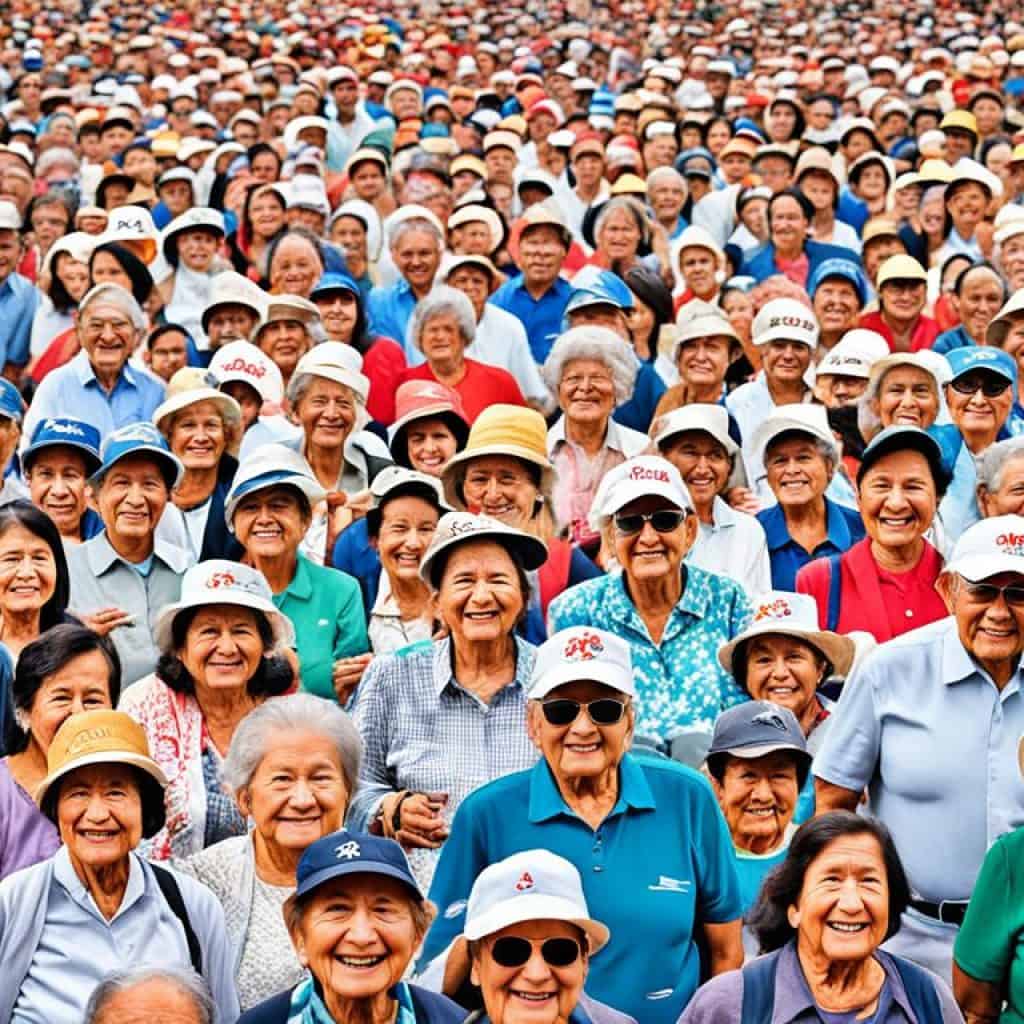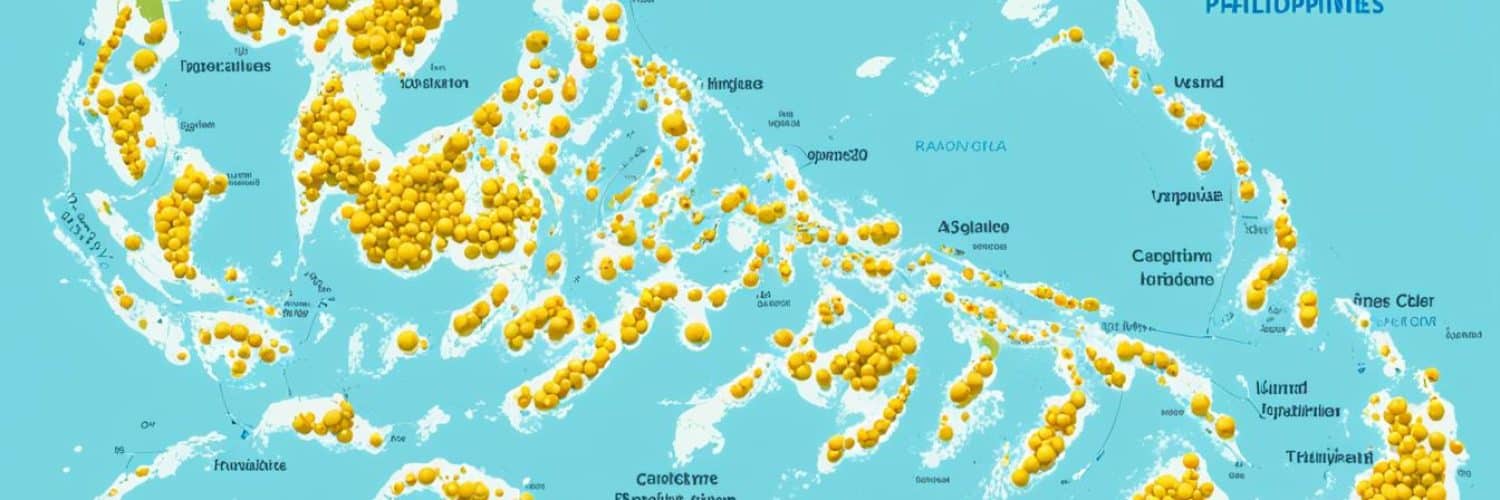How Many People In The Philippines 2024? What is the estimated Population of Philippines in 2024? Discover the latest statistics and demographics of the Philippines for the year 2024. Get ready to be amazed by the diverse and dynamic population of this Southeast Asian nation.
The Philippines, with its rich culture and breathtaking landscapes, is home to a population of over 116 million people as of 2024. But what makes this country so fascinating is the incredible variety within its population.
From its bustling cities to its serene rural areas, the Philippines boasts a range of ethnic groups, languages, and religious beliefs. With its young demographics, the country is poised for future growth and development.
Curious to learn more about the estimated Population of Philippines in 2024 and the key demographic trends shaping the nation? Join us as we delve into the fascinating world of the Philippines’ population.
Key Takeaways:
- The estimated population of the Philippines in 2024 is over 116 million.
- The Philippines ranks 13th in the world in terms of population size.
- The country is linguistically diverse, with Tagalog, Bisaya, Ilocano, and Cebuano being the most spoken languages.
- The majority of the population identifies as Christian, with Roman Catholicism being the predominant faith.
- The Philippines has a relatively young population, with a significant proportion under the age of 15.
Population Projection for 2024
The population of the Philippines is projected to reach 117,734,094 by 2024. This estimate takes into account the natural increase in population, where the number of births is expected to exceed the number of deaths. However, external migration may have an impact on the population growth, as the number of emigrants leaving the Philippines could potentially surpass the number of immigrants entering the country. Despite these factors, the average daily population increase for 2024 is estimated to be 13,750 individuals.
It is important to consider the various factors that contribute to population growth and projection. These factors include birth rates, death rates, migration patterns, and overall demographic trends. By analyzing these factors, we can gain insights into the future population dynamics of the Philippines.
To illustrate the projected population growth, we can refer to the following table:
| Year | Population (millions) |
|---|---|
| 2020 | 110.9 |
| 2021 | 112.0 |
| 2022 | 113.1 |
| 2023 | 114.4 |
| 2024 | 117.7 |
Please note that the table above provides an overview of the projected population growth and is subject to change based on future demographic trends and migration patterns.
As we can see, the population of the Philippines is expected to continue growing in the coming years. This growth presents both challenges and opportunities for the country, such as the need for sustainable development, infrastructure, and social services to support the increasing population.
Increase in Population:
- The projected population for 2024 is 117,734,094.
- The average daily population increase is estimated to be 13,750 individuals.
Impact of Migration:
“While the natural increase in population is expected to be positive, the Philippines may experience a decline in population due to external migration.”
In conclusion, the population projection for 2024 indicates continued growth in the Philippines. This growth brings both opportunities and challenges that need to be addressed to ensure the well-being and development of the country.
Demographics of the Philippines in 2023
As of January 1, 2024, the population of the Philippines was estimated to be 115,901,688 people. The country is home to a diverse array of ethnic groups, with Tagalog being the largest ethnic group, comprising 26% of the population. The Philippines boasts linguistic diversity as well, with Tagalog, Bisaya, Ilocano, and Cebuano as the most commonly spoken languages.
Religion also plays a significant role in the demographics of the Philippines, with the majority of the population identifying as Roman Catholic (78.8%). Additionally, other religions and folk or traditional religions are present in smaller numbers, while a small percentage of the population remains religiously unaffiliated.
Let’s take a closer look at the age structure of the Philippines in 2023. The population can be categorized into three age groups. The first group encompasses individuals under 15 years old, constituting 34.6% of the population. The second group comprises individuals between 15 and 64 years old, representing 61.1% of the population. Lastly, the third group includes individuals above 64 years old, making up 4.3% of the population.
| Age Group | Percentage of Population |
|---|---|
| Under 15 Years Old | 34.6% |
| 15-64 Years Old | 61.1% |
| Above 64 Years Old | 4.3% |
The demographics of the Philippines in 2023 paint a picture of a vibrant and diverse nation. While the population is relatively young, with a significant proportion under the age of 15, there is also an aging population that presents unique challenges. By understanding these demographics, policymakers and stakeholders can develop strategies to address the needs of the population and ensure sustainable growth and development.
Population Density in the Philippines
The population density in the Philippines is 387.1 people per square kilometer. However, the population density can vary significantly across different provinces and regions in the country. Some densely populated areas include Metro Manila, which has a population density of over 20,000 people per square kilometer, and other urban centers like Cebu City and Davao City. In contrast, more rural areas tend to have lower population densities. The province of Batanes, for example, has a population density of only 16 people per square kilometer.

In the table below, you can see the population density by province in the Philippines:
| Province | Population Density (people/square kilometer) |
|---|---|
| Metro Manila | 20,785.8 |
| Cebu | 583.7 |
| Cavite | 1,127.0 |
| Batangas | 580.5 |
| Palawan | 56.1 |
The population density varies depending on various factors such as infrastructure, economic opportunities, and geographical location. Urban areas tend to have higher population densities due to concentrated residential and commercial developments. In contrast, rural areas often have lower population densities due to larger land areas and smaller populations.
Understanding the population density in different regions is important for various planning and development purposes. It allows policymakers to allocate resources, plan infrastructure projects, and address the needs of growing communities effectively.
Religion in the Philippines
In the diverse cultural landscape of the Philippines, religion plays a significant role in shaping the beliefs and values of its people. The country is predominantly Christian, with 92.6% of the population identifying as Christians. The majority of Christians in the Philippines follow the Roman Catholic faith, making it the largest Christian denomination in the country.
Islam is the second-largest religion in the Philippines, with 5.5% of the population identifying as Muslims. The Muslim community mainly resides in the southern region of Mindanao and the Sulu Archipelago.
Besides Christianity and Islam, there are other religions and folk or traditional beliefs present in the Philippines, such as Buddhism, Hinduism, and Indigenous spirituality. These diverse religious practices contribute to the cultural tapestry of the nation.
It’s important to note that a small percentage of the population in the Philippines is religiously unaffiliated. These individuals may identify as atheists or agnostics, choosing not to align themselves with any particular religious belief system.
Religious Demographics in the Philippines
| Religious Affiliation | Percentage of Population |
|---|---|
| Roman Catholic | 92.6% |
| Muslim | 5.5% |
| Other Christian denominations | 1.8% |
| Iglesia ni Cristo | 0.7% |
| Other Religions/Folk Religions | 0.2% |
| Religiously Unaffiliated | 0.2% |
The table above provides an overview of the religious demographics in the Philippines. As the data indicates, Roman Catholicism holds a dominant position among the religious affiliations, comprising 92.6% of the population. Islam represents the second-largest religious group, accounting for 5.5%.
It’s important to respect and appreciate the religious diversity in the Philippines, as it contributes to the rich cultural heritage of the nation.
Age Structure in the Philippines
The age structure of the Philippines is relatively young, reflecting a vibrant and energetic population. As of 2024, the distribution of age groups in the country is as follows:
- 34.6% of the population is under 15 years old
- 61.1% of the population is between 15 and 64 years old
- 4.3% of the population is above 64 years old
This means that there are approximately 40 million young people under 15 years old, paving the way for the country’s future. The majority of the population, around 70 million individuals, falls within the productive age range of 15 to 64 years old. Additionally, there are approximately 4.9 million individuals above 64 years old, representing a smaller but significant segment of the population.
The age distribution in the Philippines showcases a diverse mix of generations, with each age group contributing to the nation’s social, cultural, and economic fabric. The young population represents a source of potential talent, while the working-age population drives innovation and productivity. The older population contributes valuable wisdom and experience.
Implications of the Age Structure
“The age structure of the Philippines holds immense potential for economic growth, social development, and intergenerational cooperation. It presents an opportunity for harnessing the energy and creativity of the youth while ensuring the well-being and inclusion of older individuals.” – Population Analyst
The relatively young age structure in the Philippines brings both opportunities and challenges. The large number of young people underscores the importance of investing in education, healthcare, and employment opportunities. By providing quality education and skills development, the country can equip its young population for the future and enhance their potential to contribute to the nation’s growth.
On the other hand, the aging population requires attention to ensure their well-being and care. Policies and programs that promote active and healthy aging, provide social support, and create opportunities for older individuals to remain engaged in society are essential.
Furthermore, the age diversity in the Philippines calls for intergenerational collaboration and cooperation. Bridging the gaps between different age groups can foster understanding, empathy, and the exchange of knowledge and experiences. This synergy can contribute to social cohesion, sustainable development, and the creation of a harmonious society.
Age Structure in Numbers
| Age Group | Population |
|---|---|
| Under 15 years old | Approximately 40 million |
| 15 to 64 years old | Approximately 70 million |
| Above 64 years old | Approximately 4.9 million |
The age structure of the Philippines, with its young population and balanced distribution across different age groups, sets the stage for a vibrant and dynamic future. By harnessing the potential of each generation, the country can build a prosperous and inclusive society for all.
Age Dependency Ratio in the Philippines
In the Philippines, the age dependency ratio is a key indicator of the burden placed on the working-age population by dependents. It provides valuable insights into the country’s demographic makeup and the challenges it faces in terms of supporting and caring for different age groups.
The total dependency ratio in the Philippines is 63.7%, indicating that more than half of the working-age population has dependents. This includes both children and elderly individuals who rely on the working-age population for their care and support.
Specifically, the child dependency ratio in the Philippines stands at 56.7%. This means that a significant proportion of the population is below the working age and requires the support and resources of the working-age population. Investing in children’s education, healthcare, and well-being is crucial to nurturing the next generation and ensuring the country’s future development.
On the other hand, the aged dependency ratio in the Philippines is relatively low at 7%. This reflects a smaller proportion of the population above the working age who rely on the working-age population for their financial and healthcare needs. However, as the country’s population ages in the coming years, the aged dependency ratio is expected to increase, leading to additional pressures on the working-age population and healthcare systems.
Developing policies and programs that address the diverse needs of different age groups is essential for promoting social welfare and sustaining economic growth. By understanding the age dependency ratio in the Philippines, policymakers, healthcare professionals, and other stakeholders can make informed decisions to better allocate resources and support the overall well-being of the population.

| Dependency Ratio | Percentage |
|---|---|
| Total Dependency Ratio | 63.7% |
| Child Dependency Ratio | 56.7% |
| Aged Dependency Ratio | 7% |
Life Expectancy in the Philippines
When it comes to life expectancy, the Philippines has made significant progress over the years. As of now, the average life expectancy in the country is 71.7 years. This means that on average, Filipinos can expect to live a fulfilling and meaningful life for more than seven decades.
Breaking it down by gender, the life expectancy at birth is 68.7 years for men and 74.7 years for women. This slight disparity can be attributed to various factors, including biological differences and lifestyle choices.
The increased life expectancy in the Philippines can be attributed to several advancements in healthcare, improved access to medical facilities, and better living standards. Efforts to promote health awareness and preventive care have also played a significant role in prolonging the lives of Filipinos.
While there is still room for improvement, the upward trend in life expectancy is a testament to the country’s commitment to the well-being of its population.
Factors Impacting Life Expectancy
Life expectancy at birth is influenced by various factors, including:
- Healthcare Access: Access to quality healthcare services and facilities greatly impacts life expectancy. When individuals have timely access to medical treatments, vaccinations, and preventive care, they are more likely to live longer, healthier lives.
- Lifestyle Choices: Personal choices such as diet, exercise, and avoiding harmful habits like smoking or excessive alcohol consumption can have a significant impact on life expectancy. Adopting a healthy lifestyle can reduce the risk of chronic diseases and improve overall well-being.
- Socioeconomic Conditions: Socioeconomic factors, such as income level, education, and employment opportunities, can influence life expectancy. Adequate access to resources and opportunities for growth can contribute to a longer and healthier life.
By addressing these factors and implementing policies that support healthcare advancements, education, and economic stability, the Philippines can further enhance its population’s life expectancy.
| Gender | Average Life Expectancy |
|---|---|
| Men | 68.7 years |
| Women | 74.7 years |
Literacy in the Philippines
The literacy rate in the Philippines is impressive, with 96.3% of adults aged 15 years and above being able to read and write. This highlights the country’s commitment to education and the importance placed on literacy.
When examining the literacy rate by gender, we see that men have a literacy rate of 95.78%, while women have a slightly higher rate of 96.79%. This indicates a relatively balanced literacy level between genders, with both men and women valuing the ability to read and write.
Focusing on the youth population between the ages of 15 and 24, the literacy rate stands at an impressive 97.94%. This underscores the importance of providing quality education to the younger generation, equipping them with the necessary skills for a bright future.
“Education is the key to unlocking one’s potential and opening doors to a world of opportunities.”
The Impact of Literacy
Literacy plays a vital role in personal and societal development. It empowers individuals to navigate the world confidently, helping them make informed decisions, access information, and engage in critical thinking. Furthermore, literacy contributes to economic growth by promoting employment opportunities and enhancing productivity.
Investing in education and ensuring high literacy rates is crucial for the Philippines’ continued development and prosperity.
Literacy Rates in the Philippines
| Literacy Rate | Male | Female |
|---|---|---|
| Adult Population (15 years and above) | 95.78% | 96.79% |
| Youth Population (15-24 years) | 97.94% | |
Providing accessible and quality education for all remains a priority for the Philippine government and society as a whole. By continuing to prioritize literacy and education, the country can nurture a knowledgeable and skilled population, driving progress and prosperity in the years to come.
Historical Population of the Philippines
The population of the Philippines has seen significant growth over time, reflecting the country’s development and changing demographics. Understanding the population history and growth trends is crucial for predicting future needs and planning for sustainable development.
In 1950, the population of the Philippines was approximately 19 million. Over the years, it has steadily increased and reached over 115 million in 2024. This remarkable growth can be attributed to various factors, including improvements in healthcare, advancements in technology, and economic development.
However, the growth rate has gradually declined over the years. In the 1950s, the population growth rate was around 3.5%, reflecting a period of rapid expansion. In 2024, the growth rate stands at 1.58%, indicating a slowing pace of population growth.
Despite the declining growth rate, the population of the Philippines is projected to continue increasing in the coming years, albeit at a slower pace. This growth will have implications for various sectors, including healthcare, education, and infrastructure.

Key Insights:
- The population of the Philippines has grown from approximately 19 million in 1950 to over 115 million in 2024.
- The growth rate has declined from around 3.5% in the 1950s to 1.58% in 2024.
- The slowing growth rate suggests a shift in the country’s demographic landscape.
- The projected population growth indicates continued expansion, although at a slower pace.
Population Growth and Projections
The population growth rate in the Philippines has been gradually decreasing since the 1950s, reflecting changes in birth rates and migration patterns. In recent years, the growth rate has stabilized at around 1.6%.
With a current population of approximately 116 million in 2024, the Philippines is projected to continue growing, albeit at a slower pace, throughout the 21st century. The population is expected to reach 119 million by 2024.
Looking further ahead, population projections indicate that the Philippines will experience continued growth throughout the century. By 2100, the population is estimated to be around 180 million.
This projected population growth has significant implications for the country, including the need for infrastructure development, provision of social services, and sustainable resource management. It highlights the importance of long-term planning and policies that address the evolving needs of a growing population.
“The future demographic landscape of the Philippines will be shaped by ongoing trends in population growth, urbanization, and socioeconomic development. It is crucial for policymakers to consider these projections and implement strategies that promote sustainable and inclusive growth.”
Population Projection Table (2020-2100)
| Year | Population |
|---|---|
| 2020 | 110 million |
| 2030 | 125 million |
| 2040 | 140 million |
| 2050 | 155 million |
| 2060 | 168 million |
| 2070 | 177 million |
| 2080 | 184 million |
| 2090 | 190 million |
| 2100 | 180 million |
These population projections indicate the potential growth and changing demographic dynamics that the Philippines may experience in the coming decades. It is essential for policymakers and stakeholders to consider these projections when formulating policies and planning for the future development of the country.
Cities and Urbanization in the Philippines
The Philippines is home to several large cities, with Quezon City as the largest, boasting a population of over 2.7 million people. Other significant urban centers include Manila, Caloocan City, and Davao. These cities serve as hubs of commerce, culture, and entertainment, attracting residents from various regions.
The urban population in the Philippines has been steadily growing, reflecting the ongoing process of urbanization in the country. This trend is driven by factors such as job opportunities, access to amenities, and improved infrastructure. With the allure of a higher quality of life, many people migrate from rural areas to seek better opportunities in urban centers.
The urbanization rate in the Philippines stands at approximately 50%, indicating that half of the country’s population resides in urban areas. This shift towards urban living has had a significant impact on the economy, as cities become engines of growth, innovation, and development.
Largest Cities in the Philippines
| City | Population |
|---|---|
| Quezon City | 2,936,116 |
| Manila | 1,780,148 |
| Caloocan City | 1,583,978 |
| Davao City | 1,634,465 |
The table above showcases some of the largest cities in the Philippines. It is important to note that population figures may vary depending on different sources and methodologies.
Urbanization brings both opportunities and challenges for the country. While cities offer better access to education, healthcare, and employment, rapid urbanization can strain resources and infrastructure. The government plays a crucial role in managing and planning urban development to ensure sustainable growth and improve the quality of life for urban dwellers.
Urbanization in the Philippines is a dynamic process that continues to shape the country’s landscape and society. As cities flourish and evolve, it is essential to strike a balance between economic progress, environmental sustainability, and social inclusivity. By harnessing the potential of urbanization, the Philippines can pave the way for a prosperous and resilient future.
Conclusion
The Philippines, with its diverse and growing population, presents both challenges and opportunities. As of 2024, the country’s population has exceeded 116 million, making it a significant player on the global stage. With a relatively young population, the Philippines has a promising future, with a substantial proportion of its citizens under the age of 15. However, the country also faces the reality of an aging population, which puts pressure on the working-age population to support and care for the elderly.
Looking ahead, the Philippines is projected to continue its growth, albeit at a slower pace. The government must carefully navigate these demographic trends to ensure sustainable development and meet the evolving needs of its population. Sustainable economic policies, investments in education and healthcare, and targeted initiatives to address income inequality will be crucial for the Philippines to harness the potential of its population and foster inclusive growth.
In summary, the Philippines’ diverse and dynamic population is a key asset for the country’s future. By understanding and addressing its demographic challenges, the Philippines can cultivate a prosperous and equitable society. With strategic planning and continued investments in human capital, the Philippines is well-positioned to navigate the complexities of population growth and seize opportunities for progress.


















Add comment